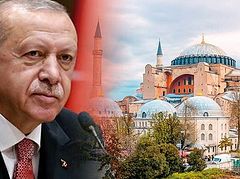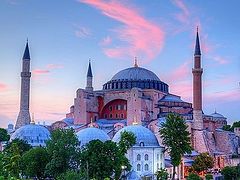Istanbul, June 9, 2020
Agia Sophia belongs to Turkey, and it can do with it as it pleases without Greece’s permission, Turkish President Recep Tayyip Erdoğan emphasized yesterday in the latest ongoing spat between Turkey and Greece over the fate of the iconic cathedral-turned-mosque-turned-museum.
“Now they’re talking about Agia Sophia,” Erdogan said in response to Greece’s reaction to his own statements about reconverting Agia Sophia into a mosque. “They say, ‘You won’t turn it into a mosque.’ Are you from the Turkish administration?” he asked, reports Romfea.
Turkey does not need to ask permission from Greece to change the status of the world-famous building, the Turkish president emphasized.
“We don’t need to get permission from you. We are waiting for the decision from the State Council and will act in accordance with it,” he said.
The State Council will review the possibility of changing the status of Agia Sophia from a museum to a mosque, thus canceling the presidential decree of 1934 that turned it into a museum in the first place, on July 2.
The Turkish Constitutional Court rejected a similar request from an NGO in September 2018, though a Turkish court turned the historic Chora Monastery from a museum into a mosque last year, thus paving the way for the conversion of Agia Sophia, many believe.
On Sunday, Devlet Bahçeli, the head of the Nationalist Movement Party spoke strongly in favor of turning Agia Sophia into a mosque once again.
“Agia Sophia is a mosque, a symbol of the Turkish Muslim people’s conquest. This is an unchanging truth that everyone must recognize. If Allah allows, then not bells, but the azan [Muslim call to prayer—O.C.] will sound forth from Agia Sophia,” the politician said confidently.
Agia Sophia, originally built as a great Orthodox cathedral in the 6th century by St. Justinian the Great when Constantinople was the capital of the Byzantine Empire, remains a point of tension between Turkey and Greece.
It was converted into a mosque when the Ottomans defeated the Byzantine Empire in 1453. In 1931, the building was secularized, and in 1935 it opened as a museum. It has been included as a UNESCO World Heritage site since 1985.





